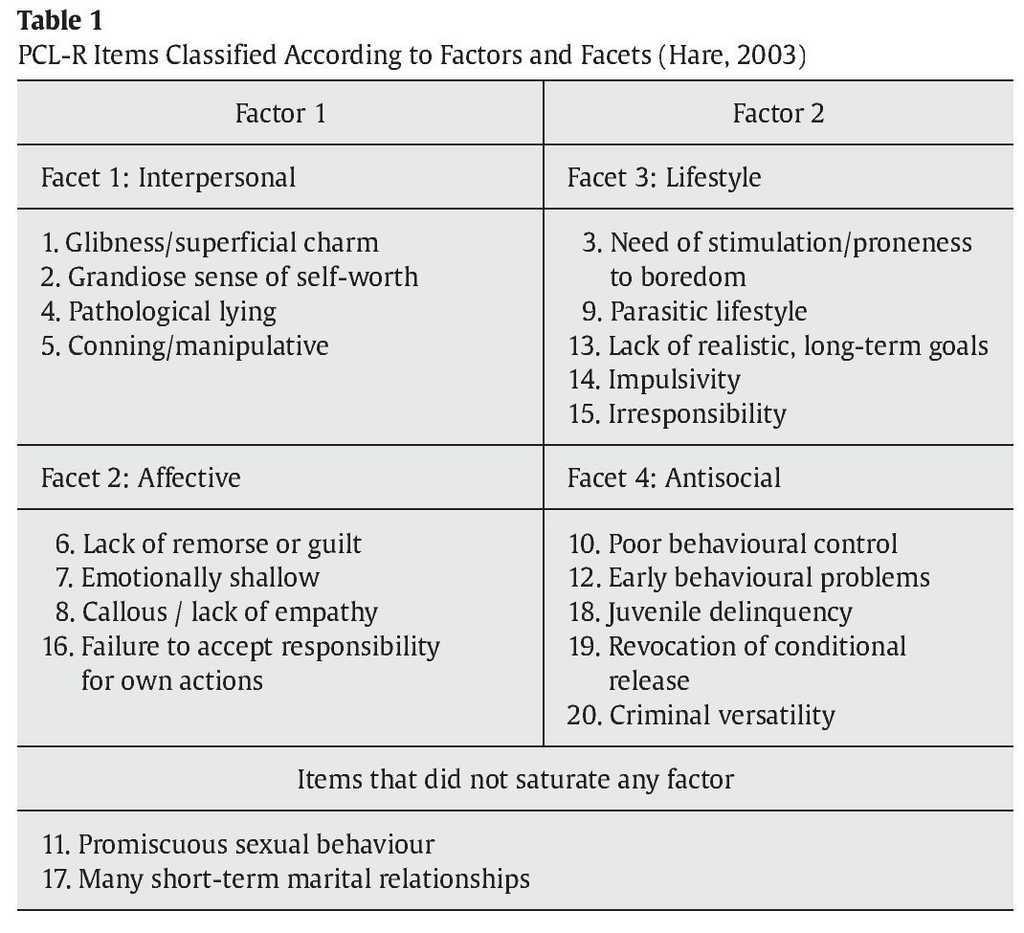The Hare Psychopathy Checklist Revised Pdf Download
View or download all content the institution has subscribed to. Download PDF Article Metrics. The Hare Psychopathy Checklist-Revised (PCL-R) and Rorschach Test.
Cover The Psychopathy Checklist or Hare Psychopathy Checklist-Revised, now the Psychopathy Checklist—revised ( PCL-R), is a tool most commonly used to assess the presence of in individuals. It is a 20-item inventory of perceived and recorded behaviors, intended to be completed on the basis of a along with a review of 'collateral information' such as official records. The PCL was originally developed in the 1970s by Canadian psychologist for use in, based partly on Hare's work with male offenders and forensic inmates in Vancouver, and partly on an influential clinical profile by American psychiatrist first published in 1941.
An individual's score may have important consequences for their future, and because the potential for harm if the test is used or administered incorrectly is considerable, Hare argues that the test should be considered valid only if administered by a suitably qualified and experienced clinician under scientifically controlled and licensed, standardized conditions. Hare receives on licensed use of the test. In terms, the current version of the checklist has two factors (sets of related scores) that correlate about 0.5 with each other, with Factor One closer to Cleckley's original personality concept than Factor Two. Hare's checklist does not incorporate the 'positive adjustment features' that Cleckley did.
Introduction to robotics oussama khatib pdf to word converter. Contents • • • • • • • • • • • PCL-R model of psychopathy [ ] The PCL-R is used for indicating a dimensional score, or a categorical diagnosis, of psychopathy for clinical, legal or research purposes. It is rated by a (such as a psychologist or other professional trained in the field of mental health, psychology, or psychiatry), using 20 items. Each of the items in the PCL-R is scored on a three-point scale according to specific criteria through file information and a. The scores are used to predict risk for criminal re-offense and probability of rehabilitation.

The current edition of the PCL-R officially lists three factors (1.a, 1.b, and 2.a), which summarize the 20 assessed areas via. The previous edition of the PCL-R listed two factors. Factor 1 is labelled 'selfish, callous and remorseless use of others'.
Factor 2 is labelled as 'chronically unstable, antisocial and socially deviant lifestyle'. There is a high risk of recidivism and mostly small likelihood of rehabilitation for those who are labelled as having 'psychopathy' on the basis of the PCL-R ratings in the manual for the test, although treatment research is ongoing. PCL-R Factors 1a and 1b are correlated with.

They are associated with extraversion. Factor 1, the so-called core personality traits of psychopathy, may even be beneficial for the psychopath (in terms of nondeviant social functioning). PCL-R Factors 2a and 2b are particularly strongly correlated to and and are associated with reactive anger, criminality, and impulsive violence. The target group for the PCL-R in prisons in some countries is criminals convicted of and/or. The quality of ratings may depend on how much background information is available and whether the person rated is honest and forthright.
Items [ ] Each of the 20 items in the PCL-R is scored on a three-point scale, with a rating of 0 if it does not apply at all, 1 if there is a partial match or mixed information, and 2 if there is a reasonably good match to the offender. This is said to be ideally done through a face-to-face interview together with supporting information on lifetime behavior (e.g.
From case files), but is also done based only on file information. It can take up to three hours to collect and review the information. Out of a maximum score of 40, the cut-off for the label of psychopathy is 30 in the United States and 25 in the United Kingdom. A cut-off score of 25 is also sometimes used for research purposes. High PCL-R scores are positively associated with measures of and,, persistent criminal behavior, and negatively associated with measures of and affiliation. Early of the PCL-R indicated it consisted of two factors.
Factor 1 captures traits dealing with the interpersonal and affective deficits of psychopathy (e.g., shallow affect, superficial charm, manipulativeness, lack of empathy) whereas factor 2 dealt with symptoms relating to antisocial behavior (e.g., criminal versatility, impulsiveness, irresponsibility, poor behavior controls, ). The two factors have been found by those following this theory to display different correlates. Componentone 2008 crack. Factor 1 has been correlated with, low anxiety, low empathy, low stress reaction and low risk but high scores on scales of achievement and social potency. In addition, the use of analysis of female offender PCL-R scores indicates factor 1 items are more important in measuring and generalizing the of psychopathy in women than factor-2 items. In contrast, factor 2 was found to be related to antisocial personality disorder, social deviance, sensation seeking, low socioeconomic status and high risk of.